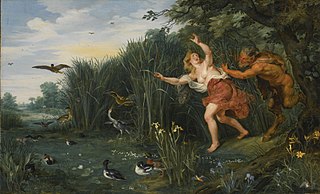
Jan Brueghelthe Younger was a Flemish Baroque painter. He was the son of Jan Brueghel the Elder, and grandson of Pieter Bruegel the Elder, both prominent painters who contributed respectively to the development of Renaissance and Baroque painting in the Habsburg Netherlands. Taking over his father's workshop at an early age, he largely painted the same subjects as his father in a style which was similar to that of his father. He gradually was able to break away from his father's style by developing a broader, more painterly, and less structured manner of painting. He regularly collaborated with leading Flemish painters of his time.
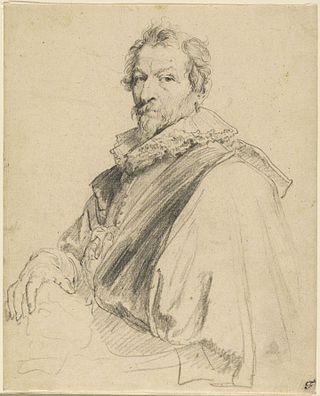
Hendrick van Balen or Hendrick van Balen I was a Flemish Baroque painter and stained glass designer. Hendrick van Balen specialised in small cabinet pictures often painted on a copper support. His favourite themes were mythological and allegorical scenes and, to a lesser extent, religious subjects. The artist played an important role in the renewal of Flemish painting in the early 17th century and was one of the teachers of Anthony van Dyck.
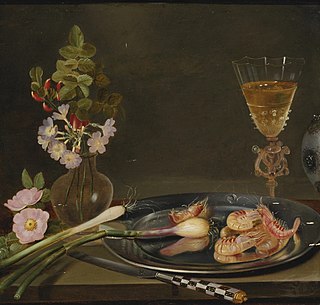
Frans Ykens was a Flemish still life painter active in Antwerp and Brussels in the 17th century. He is mainly known for his flower pieces and fruit still lifes and also painted banquet pieces, pronkstillevens, garland paintings and larger game pieces.

Ambrosius Brueghel was a Flemish painter from the famous Brueghel family of artists. Less prolific and less well-known than a number of his family members, his oeuvre is not very well understood and is believed to comprise Baroque still lifes, garland paintings as well as landscapes.
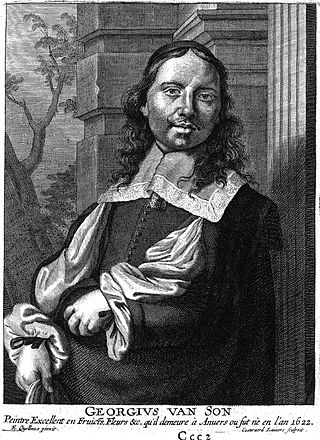
Joris van Son or Georg van Son was a Flemish still life painter who worked in a number of sub-genres but is principally known for his still lifes of fruit. He also painted flowers, banquets, vanitas still lifes and pronkstillevens. He is known to have painted fish still lifes representing the Four Elements, and also collaborated with figure artists on 'garland paintings', which typically represent a devotional image framed by a fruit or flower garland.

Jan van Balen was a Flemish painter known for his Baroque paintings of history and allegorical subjects. He also painted landscapes and genre scenes.
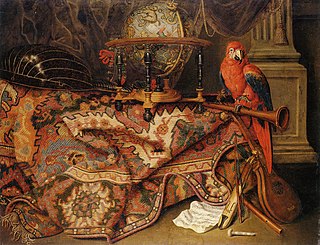
Willem Gabron or Guiliam Gabron, was a Flemish Baroque still life painter, who worked in a wide range of genres including fruit pieces, vanitas still lifes, flower still lifes, game pieces and breakfast pieces. Gabron was also a gifted animalier and often included living animals in his still life scenes. He initially worked in a monochrome style but developed a more colourful palette after a long stay in Italy.

Jacob Denys or Jacob Denys (II) (1644–1708) was a Flemish Baroque painter. His known works are mainly portraits. He also painted landscapes and history paintings. After training in Antwerp, he worked for a long time in Italy where he enjoyed the patronage of Duke of Mantua, Ferdinando Gonzaga, and the Duke of Tuscany, Cosimo III de' Medici.

Gysbrecht Thys or Gysbrechts Thys was a Flemish painter active in Antwerp known for his religious and mythological works as well as for his nudes. He also painted landscapes. Very few paintings have been attributed to the artist to date.

Jan Pauwel Gillemans the Elder was a Flemish goldsmith and still life painter who is known for his fruit still lifes, flower pieces, vanitas still lifes and pronkstillevens.

Jan Frans van Son or Frans van Son was a Flemish still life painter. The son of the prominent Antwerp still life painter Joris van Son, he trained with another prominent still life artist Jan Pauwel Gillemans the Elder. He left for England at a young age and had a successful career in London. He painted flower pieces, fruit still lifes and banquet still lifes.

Jan Baptist Bosschaert or Jan Baptist Bosschaert the Younger was a Flemish still life painter who is principally known for his decorative still lifes with flowers. He collaborated with figure artists on compositions which combined allegorical or mythological scenes with a still life element. He was active in Antwerp.

Gaspar Peeter Verbruggen the Elder was a Flemish painter of flowers and garland paintings.

Gaspar Peeter Verbruggen or Gasparo Pedro Verbruggen was a Flemish still life painter who is principally known for his decorative still lifes with flowers and fruit. He collaborated with figure artists on compositions which combined figures with a still life element. He was active in Antwerp and The Hague.

Peter Ykens, was a Flemish painter mainly known for his history paintings and portraits. He regularly collaborated with specialist still painters and landscape artists for whose works he provided the staffage.
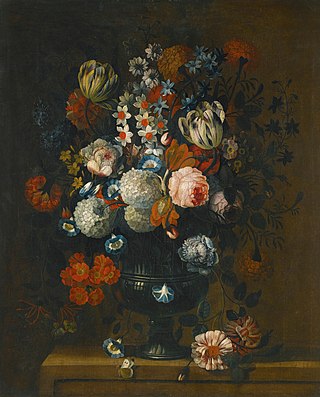
Simon Hardimé (1672–1737) was a Flemish painter of mixed Walloon and Flemish descent. He is known for his paintings of flowers. He trained in Antwerp and later worked for a few years in the Dutch Republic. He then moved to London where he remained the rest of his life. His patrons included the bourgeoisie in Brussels and Antwerp and aristocrats in the Netherlands and England.

Joannes Hermans, called Monsú Aurora, was a Flemish painter of animals and still lifes of game, fruit and flowers who worked in Italy and Antwerp where he contributed to the development of the Baroque still life genre.

Jan Peeter van Bredael the Elder or Jan Pieter van Bredael the Elder was a Flemish painter, art restorer and art dealer. He is known for his still lifes of flowers and fruits, game and Italianate landscapes. He was a member of the prominent artistic family van Bredael from Antwerp.

Pieter Hardimé was a Flemish painter known for his paintings of flowers. He trained in Antwerp and later moved to the Dutch Republic where he worked in The Hague. He was active as a decorative painter of flowers for wall and ceiling decorations, often in collaboration with Mattheus Terwesten.
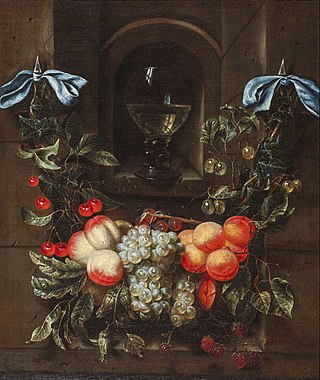
Maria Tassaert was a Flemish still life painter active in Antwerp. She had a short career during which she painted garland paintings, a type of still life painting comprising a garland of flowers around a devotional or other image. She was a member of the Tassaert family of artists, which was active in the Habsburg Netherlands, France, Prussia and England in the 17th and 18th centuries.
























